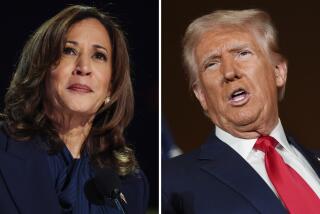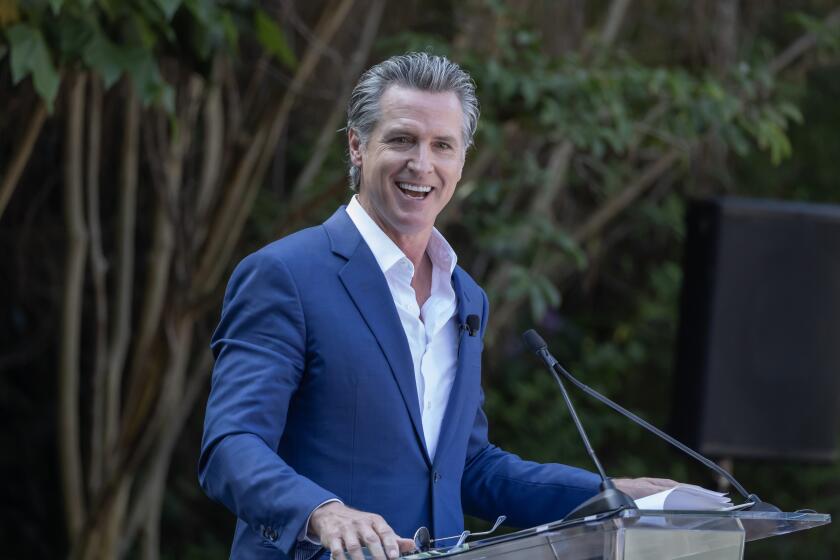Clinton Plan for Immunization Raises Questions
When President Clinton unveiled his first domestic policy initiative in early 1993, he promised that the groundbreaking childhood vaccination program would reverse a declining trend of immunization in the United States and prevent many tragic infant deaths.
“America’s immunization delivery system is deteriorating rapidly, . . .” Health and Human Services Secretary Donna Shalala warned. “The problem is enormous.”
From the outset, Clinton’s well-intentioned immunization effort was widely touted by Administration officials as a trial run for other, more ambitious domestic policy initiatives being promised by the President--including health care and welfare reform.
But just as the Administration is gearing up to implement its massive new Vaccines for Children program beginning Oct. 1, there is evidence that the President and top officials overstated the seriousness of the immunization problem the program is designed to cure.
A little-heralded survey by the federal Centers for Disease Control and Prevention shows that the nation is much closer than Administration officials originally acknowledged to achieving the program’s goal of immunizing 90% of all preschool children. The latest government figures show the rate at between 80% and 90%.
Furthermore, many public health experts, members of Congress and state officials now say they believe that the $500 million-a-year program to buy discount vaccines and distribute them to private physicians may only be marginally effective in improving those vaccination rates.
Within the next few days, members of Congress are expected to release a General Accounting Office report that raises serious questions about the Administration’s ability to safely implement the program this fall as planned.
According to sources familiar with the report, the GAO is concerned whether the proposed government-run distribution system can ensure that the vaccines, which are highly sensitive to temperature changes, will be safely transported. In addition, it has raised questions about the adequacy of the computer software in the vaccine-tracking system.
The GAO findings are certain to fuel complaints that the program far exceeds what Congress intended when it passed the legislation authorizing the initiative.
In addition, Sen. Dale Bumpers, a Democrat from the President’s home state of Arkansas and a longtime proponent of expanded childhood immunization, plans to introduce an amendment to the pending Health and Human Services spending bill that would halt funding for the most controversial element--the government-run vaccine distribution system--until questions about it are resolved.
Faced with the barrage of criticism, Shalala blames the pharmaceutical industry, contending that it has inflamed the controversy because the program would reduce vaccine makers’ profits.
“The critics, in particular the vaccine manufacturers, did not support the legislation establishing the vaccine program and are now simply raising one issue after another . . . to undercut congressional support for the program,” Shalala said.
For years, the government has been able to buy vaccines from manufacturers at discount prices to be used to provide children with free or low-cost inoculations in public health clinics. The new program would go one step further by supplying as many as 79,000 private physicians with the free vaccines to immunize Medicaid recipients who are children, uninsured children and Native Americans against such illnesses as measles, mumps, rubella, pertussis and polio.
Clinton, who unveiled his childhood immunization plan on Feb. 12, 1993, just three weeks after he became President, chose this as his first domestic initiative because it dovetailed with his goal of reforming health care and fulfilled a promise that he had made to the Children’s Defense Fund, an organization supported by both Shalala and First Lady Hillary Rodham Clinton that has long campaigned for a national vaccine program. In addition, it was consistent with his pledge to curb profiteering by the pharmaceutical industry.
From the start, some champions of childhood immunization viewed the new program as unnecessary. But as the initiative has taken shape, they have become alarmed. As Bumpers sees it, the government’s new system for distributing vaccines looms as “an unmitigated disaster” because it cannot guarantee the integrity of the drugs.
Until now, all government-purchased vaccines have been shipped directly to public clinics through a distribution network run by the nation’s pharmaceutical manufacturers. In its place, the Administration has decided to create a labyrinthine new federal system to be operated by the General Services Administration, whose primary responsibility is government procurement. Much-criticized over the years as wasteful and inefficient, it has no experience in shipping sensitive biological material.
Under the GSA plan, one-third of the nation’s childhood vaccine supply would be distributed to public and private clinics and doctors’ offices through a mammoth, government-run warehouse in Burlington, N.J., where the agency also stores paint, adhesives and other flammable materials. If the facility caught fire, the nation could lose a substantial part of its available vaccines.
But most distressing to many public health professionals is that the new program de-emphasizes proven tools for getting preschoolers vaccinated: parental and physician education, community outreach, longer clinic hours and computer tracking and follow-up programs.
In fact, public health officials in some states have complained they have been forced to shift resources away from these strategies to fund the time-consuming task of recruiting private physicians to participate in the new program.
Dr. Walter A. Orenstein, director of the National Immunization Program for the Centers for Disease Control and Prevention, emphasized that the Vaccines for Children program is just one part of the Administration’s overall effort to ensure that “kids who need vaccines” receive them.
According to Orenstein, the Administration has proposed spending $175 million in fiscal 1995--a fourfold increase over 1993--for the states to spend on education and outreach, $28.7 million to measure the results, $5 million to encourage states to develop early detection systems for the outbreaks of communicable diseases and $4.2 million to aid private efforts to increase community involvement.
Most of the new funds, nonetheless, will be devoted to making free vaccines available to needy children through private physicians.
Dr. Ronald J. Saldarini, president of Lederle-Praxis Biologicals in Wayne, N.J., one of four companies that manufactures vaccines in the United States, said the emphasis on purchasing at the expense of other measures “is like putting one tractor tire on the Volkswagen and leaving the other three tires flat.”
The program’s architects say it will remove the barrier of cost for unvaccinated children. But because physicians will be permitted to charge their standard $30-to-$50 fee for an office visit and about $15 to administer the shot, critics note that it will still be cheaper for parents to go to public health clinics, where the vaccines are already administered at little or no charge.
Clinton said the initiative was necessary because the cost of immunizing a child had risen from $23 to more than $200 in the previous 10 years, putting it out of reach for many low-income families. He did not mention that the government was already spending $300 million a year to supply free vaccines to public clinics.
Not surprisingly, the pharmaceutical industry promptly challenged the President’s figures, arguing that four-fifths of the price increase stemmed from the development of two new vaccines and the imposition of a federal excise tax in 1988. Drug company officials also insisted that there was no evidence to prove that cost is a major barrier to immunization.
Under the new program, the Administration estimates that it will be buying 80% of all vaccines manufactured in the United States at a discounted price--up from 50% now. The regular price for the standard 15 shots administered to preschoolers is $270; the discounted price is $129.
Months after Clinton made his call for a universal vaccination program, when the CDC made public its 1993 immunization statistics, it became clear that the dire warnings issued by the President and Shalala were based on outdated data.
The Administration relied on 1991 figures showing that little more than 50% of all preschoolers had been properly vaccinated. The CDC’s survey for the third quarter of 1993 found the rate was 90% for diphtheria, pertussis and tetanus; 80% for polio, and 86% for measles, mumps and rubella.
Officials attributed the increase, in part, to heightened awareness arising from a 1991 measles epidemic.
Robert Goldberg, a public health researcher at Brandeis University, insisted that Administration officials had access to 1992 CDC survey results showing an 80% immunization rate at the time the new program was unveiled in early 1993. But, he said, they chose to use the misleading earlier data. HHS officials denied that they had tried to deceive the public.
In Congress, the President’s proposal was greeted with skepticism by both Democrats and Republicans. A compromise bill, enacted in August, 1993, sought to limit free vaccines primarily to children of low-income families.
But critics in Congress said they fear the Administration may allow the program to be expanded to include the children of middle-income and wealthy families. Moreover, they are concerned that failure to enact tough controls could lead some physicians to use the cheaper vaccines purchased through the government for private patients outside the new program. Administration officials noted that such use would constitute fraud.
Experts said the new program will move the country substantially in the direction of a universal system of free vaccinations. Even HHS officials predicted that, using the expanded supply of low-cost vaccines offered by the federal government, about half of the states would soon be guaranteeing free vaccines for citizens of all income levels.
Critics in Congress also said the Administration exceeded the terms of the authorizing legislation by creating a government-run distribution system for the low-cost vaccines.
HHS officials insisted they were forced to create a government distribution system because Congress did not provide money to pay for shipping by pharmaceutical companies. At the same time, they acknowledge that Shalala had declined an offer from congressional leaders last fall to provide extra funding that would have preserved the drug industry’s role in shipping the vaccines.
The Administration turned to the GSA to distribute the vaccines after the Defense Department and Department of Veterans Affairs declined to do it. In fact, both the Pentagon and the Veterans Affairs Department recently canceled their programs for distributing vaccines to children of military families based on findings that the pharmaceutical industry could do it more cheaply.
At one point, the GSA also tried to escape the assignment. In a May 19 letter to CDC Director David Satcher obtained by The Times, GSA Administrator Roger W. Johnson said that because of opposition by Congress and the pharmaceutical companies, he believed “the chances for success have disappeared and the possibility of an acrimonious disaster has now surfaced.”
The GSA’s plans have come under heavy fire in Congress.
“I just think it’s nuts,” said Rep. Scott L. Klug (R-Wis.), another critic of the plan. “Why would it make any sense whatsoever to essentially bring immunizations from all over the country, store them with a government agency that has no experience to do this and then, in addition, put them next to a room that I assume is dangerous or they wouldn’t label it a flammable room?”
In response, Administration officials said no more than 8% of the nation’s supply of the vaccines will be stored in the facility at any one time. They also said the distribution center has double-thick fire walls and that the GSA has agreed to abide by stringent Food and Drug Administration rules for handling delicate vaccines.
“If we can do it (logistics) for something like Desert Shield or Desert Storm, there’s no reason why we can’t do it for something like war on disease here at home,” said a top GSA official.
Still, experts said storing 8% of all existing vaccines in a facility with flammable materials is cause for concern.
“That is an incredible concentration of all vaccines in one period of time,” said Chris Grant, vice president for Connaught Labs Inc., a vaccine manufacturer. “It being such a fragile, expensive product to re-create because it takes so long to create, there’s no manufacturer in the country that comes close to having such a high amount.”
The Administration said it will be able to save significant sums by shipping the vaccines from various manufacturers in large, consolidated quantities at a discounted rate provided under a massive Federal Express contract for the entire federal government. But Bumpers and pharmaceutical manufacturers disputed that claim.
“Their alleged savings, I think, are grossly exaggerated,” Bumpers said, contending that the Administration has put the figure as high as $30 million.
Public health officials who must administer the new program are not uniformly opposed to it, even though some have spoken out against the expenditure of more money for vaccines. In states such as California with a high Medicaid population, it is more popular than in rural states where most children are vaccinated at free public clinics.
George W. Rutherford, deputy director for prevention services in Sacramento, estimated that the program will save California taxpayers about $40 million, primarily because the federal government will now pay for vaccinating Medicaid patients. “We’re basically enthusiastic about it,” he said.
In Mississippi, however, F. E. Thompson Jr., the state health officer, said the new program is unnecessary and wasteful.
“Instead of providing additional nurses to give shots or additional clerical staff to send reminder notices to parents or computerized tracking system to keep track of children’s immunization, we’re spending money on large amounts of vaccine that we well may not even need,” he said.
Simply providing free vaccines to physicians is no guarantee that children will get the shots, experts said. In California, according to David Wood, UCLA professor of pediatrics, studies show that doctors frequently fail to immunize children who come in for checkups.
“Education and outreach are a proven success,” Bumpers said. “That’s where the money should have been put. We didn’t need to put all that much more money into vaccine.”
Immunization Program
Here is a recommended immunization program for children from birth to 2 years old. The regular price of the vaccine for the standard 15 shots administered to preschoolers is $270; the discounted price would be $129: VACCINE: DOSES Diphtheria, pertussis, tetanus: 3 Polio: 4 Measles, mumps, rubella: 2 Diphtheria, tetanus toxoids and acelluar pertussis: 2 Hepatitis B: 3 Haemophilus influenzae type b: 1 Sources: Centers for Disease Control and Prevention; U.S. Department of Health and Human Services
More to Read
Get the L.A. Times Politics newsletter
Deeply reported insights into legislation, politics and policy from Sacramento, Washington and beyond. In your inbox three times per week.
You may occasionally receive promotional content from the Los Angeles Times.






